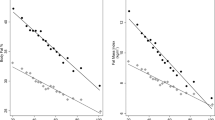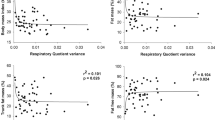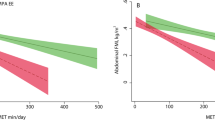Abstract
Objective:
To investigate energy expenditure in lean and obese individuals, focusing particularly on physical activity and severely obese individuals.
Design:
Total daily energy expenditure (TDEE) was assessed using doubly labeled water, resting metabolic rate (RMR) by indirect calorimetry, activity energy expenditure (AEE) by difference and time spent in physical activity by multisensor activity monitors.
Subjects:
In all, 177 lean, Class I and severely obese individuals (age 31–56 years, body mass index 20–64 kg m−2) were analyzed.
Results:
All components of energy expenditure were elevated in obese individuals. For example, TDEE was 2404±95 kcal per day in lean and 3244±48 kcal per day in Class III obese individuals. After appropriate adjustment, RMR was similar in all groups. Analysis of AEE by body weight and obesity class indicated a lower AEE in obese individuals. Confirming lower physical activity, obese individuals spent less time engaged in moderate-to-vigorous physical activity (2.7±1.3, 1.8±0.6, 2.0±1.4 and 1.2±1.0 h per day in lean, Class I, Class II and Class III individuals) and more time in sedentary behaviors.
Conclusions:
There was no indication of metabolic efficiency in even the severely obese, as adjusted RMR was similar across all groups. The higher AEE observed in the obese is consistent with a higher cost of activities due to higher body weight. However, the magnitude of the higher AEE (20–25% higher in obese individuals) is lower than expected (weight approximately 100% higher in Class III individuals). Confirming a lower volume of physical activity in the obese, the total time spent in moderate-to-vigorous physical activity and average daily metabolic equivalent of task level were lower with increasing obesity. These findings demonstrate that high body weight in obese individuals leads to a high TDEE and AEE, which masks the fact that they are less physically active, which can be influenced by duration or intensity of activity, than in lean individuals.
This is a preview of subscription content, access via your institution
Access options
Subscribe to this journal
Receive 12 print issues and online access
$259.00 per year
only $21.58 per issue
Buy this article
- Purchase on Springer Link
- Instant access to full article PDF
Prices may be subject to local taxes which are calculated during checkout


Similar content being viewed by others
References
Cook CM, Schoeller DA . Physical activity and weight control: conflicting findings. Curr Opin Clin Nutr Metab Care 2011; 14: 419–424.
Sturm R . Increases in clinically severe obesity in the United States, 1986–2000. Arch Intern Med 2003; 163: 2146–2148.
Sturm R . Increases in morbid obesity in the USA: 2000–2005. Public Health 2007; 121: 492–496.
Brown CD, Higgins M, Donato KA, Rohde FC, Garrison R, Obarzanek E et al. Body mass index and the prevalence of hypertension and dyslipidemia. Obes Res 2000; 8: 605–619.
Park YW, Zhu S, Palaniappan L, Heshka S, Carnethon MR, Heymsfield SB . The metabolic syndrome: prevalence and associated risk factor findings in the US population from the Third National Health and Nutrition Examination Survey, 1988–1994. Arch Intern Med 2003; 163: 427–436.
Ravussin E, Lillioja S, Knowler WC, Christin L, Freymond D, Abbott WG et al. Reduced rate of energy expenditure as a risk factor for body-weight gain. N Engl J Med 1988; 318: 467–472.
Roberts SB, Savage J, Coward WA, Chew B, Lucas A . Energy expenditure and intake in infants born to lean and overweight mothers. N Engl J Med 1988; 318: 461–466.
DeLany J, Bray G, Harsha D, Volaufova J . Energy expenditure and substrate oxidation predict change in body fat in children. Am J Clin Nutr 2006; 84: 862–870.
Miller DS, Parsonage S . Resistance to slimming: adaptation or illusion? Lancet 1975; 1: 773–775.
Buscemi S, Verga S, Caimi G, Cerasola G . Low relative resting metabolic rate and body weight gain in adult Caucasian Italians. Int J Obes 2005; 29: 287–291.
Prentice AM, Black AE, Coward WA, Davies HL, Goldberg GR, Murgatroyd PR et al. High levels of energy expenditure in obese women. BMJ (Clin Res Ed) 1986; 292: 983–987.
Chong PK, Jung RT, Rennie MJ, Scrimgeour CM . Energy expenditure in lean and obese diabetic patients using the doubly labelled water method. Diabet Med 1993; 10: 729–735.
Prentice AM, Black AE, Coward WA, Cole TJ . Energy expenditure in overweight and obese adults in affluent societies: an analysis of 319 doubly-labelled water measurements. Eur J Clin Nutr 1996; 50: 93–97.
DeLany JP, Bray GA, Harsha DW, Volaufova J . Energy expenditure in African American and white boys and girls in a 2-y follow-up of the Baton Rouge Children’s Study. Am J Clin Nutr 2004; 79: 268–273.
James WP, Davies HL, Bailes J, Dauncey MJ . Elevated metabolic rates in obesity. Lancet 1978; 1: 1122–1125.
Hoffmans M, Pfeifer WA, Gundlach BL, Nijkrake HG, Oude Ophuis AJ, Hautvast JG . Resting metabolic rate in obese and normal weight women. Int J Obes 1979; 3: 111–118.
Ravussin E, Burnand B, Schutz Y, Jequier E . Twenty-four-hour energy expenditure and resting metabolic rate in obese, moderately obese, and control subjects. Am J Clin Nutr 1982; 35: 566–573.
Rising R, Harper IT, Fontvielle AM, Ferraro RT, Spraul M, Ravussin E . Determinants of total daily energy expenditure: variability in physical activity. Am J Clin Nutr 1994; 59: 800–804.
Salbe AD, Weyer C, Harper I, Lindsay RS, Ravussin E, Tataranni PA . Assessing risk factors for obesity between childhood and adolescence: II. Energy metabolism and physical activity. Pediatrics 2002; 110 (Part 1): 307–314.
Weinsier RL, Hunter GR, Desmond RA, Byrne NM, Zuckerman PA, Darnell BE . Free-living activity energy expenditure in women successful and unsuccessful at maintaining a normal body weight. Am J Clin Nutr 2002; 75: 499–504.
Das SK, Saltzman E, McCrory MA, Hsu LK, Shikora SA, Dolnikowski G et al. Energy expenditure is very high in extremely obese women. J Nutr 2004; 134: 1412–1416.
Verga S, Buscemi S, Caimi G . Resting energy expenditure and body composition in morbidly obese, obese and control subjects. Acta Diabetol 1994; 31: 47–51.
Redman LM, Heilbronn LK, Martin CK, deJonge L, Williamson DA, DeLany JP et al. Metabolic and behavioral compensations in response to caloric restriction: implications for the maintenance of weight loss. PLoS One 2009; 4: e4377.
Schoeller DA . Measurement of energy expenditure in free-living humans by using doubly labeled water. J Nutr 1988; 118: 1278–1289.
Racette SB, Schoeller DA, Luke AH, Shay K, Hnilicka J, Kushner RF . Relative dilution spaces of 2H- and 18O-labeled water in humans. Am J Physiol 1994; 267 (Part 1): E585–E590.
Weir JB . New methods for calculating metabolic rate with special reference to protein metabolism. J Physiol 1949; 109: 1–9.
Cunningham JJ . Body composition as a determinant of energy expenditure: a synthetic review and a proposed general prediction equation [see comments]. Am J Clin Nutr 1991; 54: 963–969.
Ravussin E, Bogardus C . Relationship of genetics, age, and physical fitness to daily energy expenditure and fuel utilization [Review]. Am J Clin Nutr 1989; 49: 968–975.
Arciero PJ, Goran MI, Poehlman ET . Resting metabolic rate is lower in women than in men. J Appl Physiol 1993; 75: 2514–2520.
Jakicic JM, Wing RR . Differences in resting energy expenditure in African-American vs. Caucasian overweight females. Int J Obes Relat Metab Disord 1998; 22: 236–242.
Hunter GR, Weinsier RL, Darnell BE, Zuckerman PA, Goran MI . Racial differences in energy expenditure and aerobic fitness in premenopausal women1. Am J Clin Nutr 2000; 71: 500–506.
Weijs PJ . Validity of predictive equations for resting energy expenditure in US and Dutch overweight and obese class I and II adults aged 18–65 y. Am J Clin Nutr 2008; 88: 959–970.
Gibney ER, Murgatroyd P, Wright A, Jebb S, Elia M . Measurement of total energy expenditure in grossly obese women: comparison of the bicarbonate-urea method with whole-body calorimetry and free-living doubly labelled water. Int J Obes Relat Metab Disord 2003; 27: 641–647.
Westerterp KR, Saris WH, Soeters PB, ten Hoor F . Determinants of weight loss after vertical banded gastroplasty. Int J Obes 1991; 15: 529–534.
Feurer ID, Crosby LO, Buzby GP, Rosato EF, Mullen JL . Resting energy expenditure in morbid obesity. Ann Surg 1983; 197: 17–21.
Monda M, Messina G, Mangoni C, De Luca B . Resting energy expenditure and fat-free mass do not decline during aging in severely obese women. Clin Nutr 2008; 27: 657–659.
Anton-Kuchly B, Roger P, Varene P . Determinants of increased energy cost of submaximal exercise in obese subjects. J Appl Physiol 1984; 56: 18–23.
Browning RC, Kram R . Energetic cost and preferred speed of walking in obese vs. normal weight women. Obesity 2005; 13: 891–899.
Browning RC, Baker EA, Herron JA, Kram R . Effects of obesity and sex on the energetic cost and preferred speed of walking. J Appl Physiol 2006; 100: 390–398.
Peyrot N, Thivel D, Isacco L, Morin J-B, Duche P, Belli A . Do mechanical gait parameters explain the higher metabolic cost of walking in obese adolescents? J Appl Physiol 2009; 106: 1763–1770.
Schoeller DA, Shay K, Kushner RF . How much physical activity is needed to minimize weight gain in previously obese women? Am J Clin Nutr 1997; 66: 551–556.
Schoeller DA, Jefford G . Determinants of the energy costs of light activities: inferences for interpreting doubly labeled water data. Int J Obes Relat Metab Disord 2002; 26: 97–101.
van Mil EG, Westerterp KR, Kester AD, Curfs LM, Gerver WJ, Schrander-Stumpel CT et al. Activity related energy expenditure in children and adolescents with Prader–Willi syndrome. Int J Obes Relat Metab Disord 2000; 24: 429–434.
Schulz LO, Schoeller DA . A compilation of total daily energy expenditures and body weights in healthy adults. Am J Clin Nutr 1994; 60: 676–681.
Maffeis C, Schutz Y, Schena F, Zaffanello M, Pinelli L . Energy expenditure during walking and running in obese and nonobese prepubertal children. J Pediatr 1993; 123: 193–199.
Banks E, Lim L, Seubsman SA, Bain C, Sleigh A . Relationship of obesity to physical activity, domestic activities, and sedentary behaviours: cross-sectional findings from a national cohort of over 70 000 Thai adults. BMC Public Health 2011; 11: 762.
Buchowski MS, Cohen SS, Matthews CE, Schlundt DG, Signorello LB, Hargreaves MK et al. Physical activity and obesity gap between black and white women in the southeastern US. Am J Prev Med 2010; 39: 140–147.
Kushner RF, Racette SB, Neil K, Schoeller DA . Measurement of physical activity among black and white obese women. Obes Res 1995; 3 (Suppl 2): 261s–265s.
Sharp TA, Bell ML, Grunwald GK, Schmitz KH, Sidney S, Lewis CE et al. Differences in resting metabolic rate between white and African-American young adults. Obes Res 2002; 10: 726–732.
Weyer C, Snitker S, Bogardus C, Ravussin E . Energy metabolism in African Americans: potential risk factors for obesity. Am J Clin Nutr 1999; 70: 13–20.
Blanc S, Schoeller DA, Bauer D, Danielson ME, Tylavsky F, Simonsick EM et al. Energy requirements in the eighth decade of life. Am J Clin Nutr 2004; 79: 303–310.
Carpenter WH, Fonong T, Toth MJ, Ades PA, Calles-Escandon J, Walston JD et al. Total daily energy expenditure in free-living older African-Americans and Caucasians. Am J Physiol 1998; 274 (Part 1): E96–E101.
Weinsier RL, Hunter GR, Zuckerman PA, Redden DT, Darnell BE, Larson DE et al. Energy expenditure and free-living physical activity in black and white women: comparison before and after weight loss. Am J Clin Nutr 2000; 71: 1138–1146.
Acknowledgements
This study was funded by the Commonwealth of Pennsylvania Department of Health.
Author information
Authors and Affiliations
Corresponding author
Ethics declarations
Competing interests
JMJ conflicts of interest: Scientific Advisory Board for Alere Wellbeing, Honorarium for scientific presentation from JennyCraig/Nestle Nutrition Institute and Research funding provided to Pitt by BodyMedia Inc. The other authors declare no conflict of interest.
Rights and permissions
About this article
Cite this article
DeLany, J., Kelley, D., Hames, K. et al. High energy expenditure masks low physical activity in obesity. Int J Obes 37, 1006–1011 (2013). https://doi.org/10.1038/ijo.2012.172
Received:
Revised:
Accepted:
Published:
Issue Date:
DOI: https://doi.org/10.1038/ijo.2012.172
Keywords
This article is cited by
-
Determinants of physical activity in newly diagnosed obstructive sleep apnea patients: testing the health action process approach
Journal of Behavioral Medicine (2024)
-
Measured vs estimated resting energy expenditure in children and adolescents with obesity
Scientific Reports (2023)
-
The resting metabolic rate in women with polycystic ovary syndrome and its relation to the hormonal milieu, insulin metabolism, and body fat distribution: a cohort study
Journal of Endocrinological Investigation (2019)
-
Serum Metabolomics of Activity Energy Expenditure and its Relation to Metabolic Syndrome and Obesity
Scientific Reports (2018)
-
Exercise, energy balance and body composition
European Journal of Clinical Nutrition (2018)



